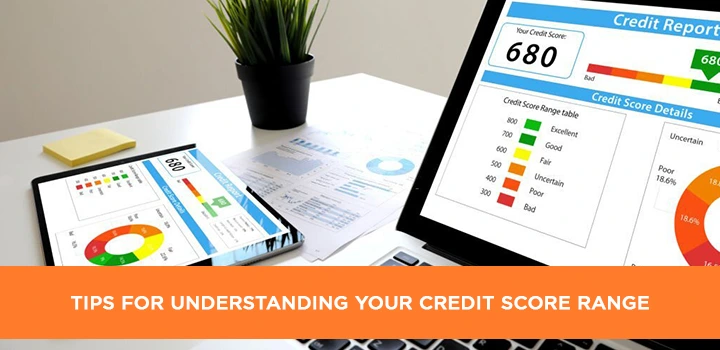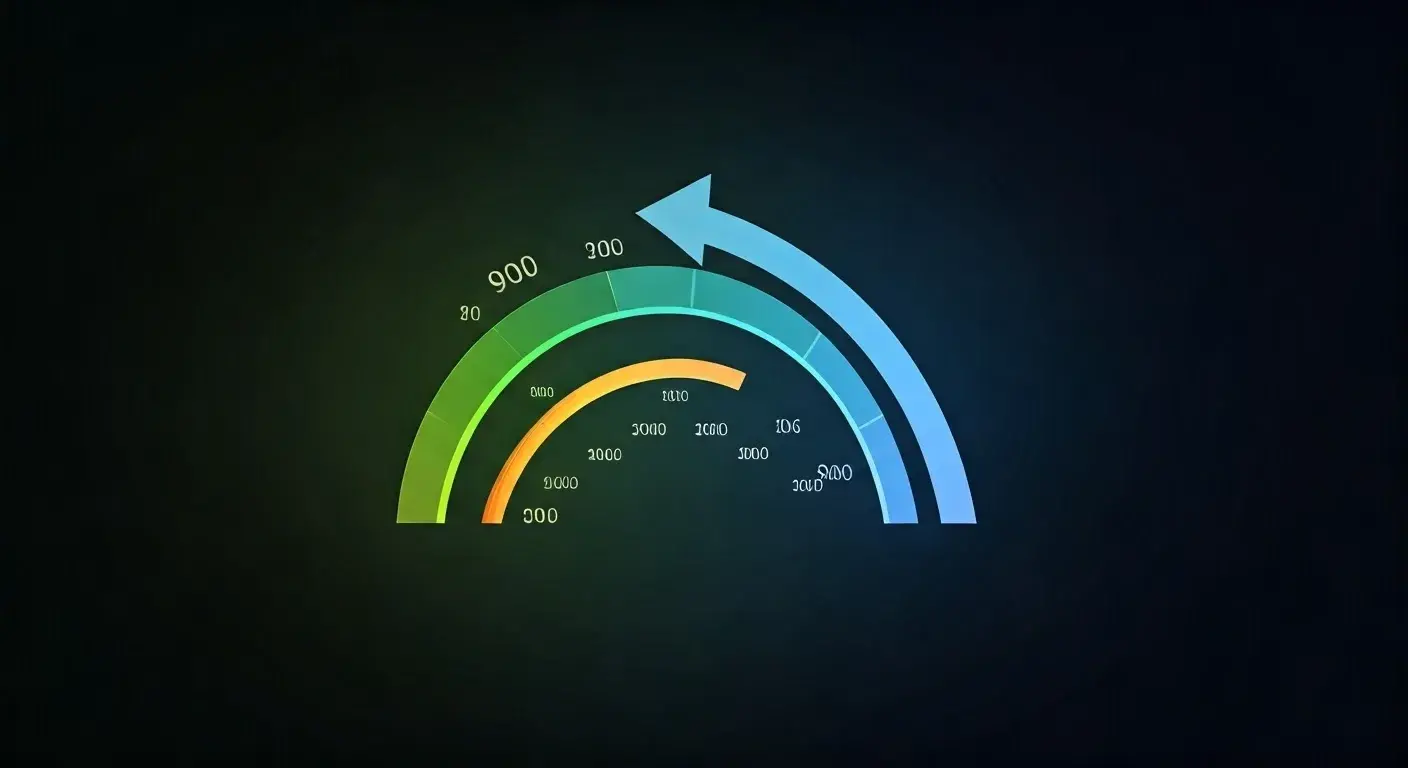-
Posted on: 24 Feb 2023

-
Understanding your credit score range is fundamental to navigating the financial landscape. This guide offers actionable tips to demystify credit score tiers, empowering you to make informed decisions about loans, credit cards, and future financial goals. Learn what your score truly signifies and how to leverage this knowledge.
What Exactly Is a Credit Score?
At its core, a credit score is a three-digit number that acts as a snapshot of your creditworthiness. Lenders use this number to assess the risk associated with lending you money. A higher score generally indicates a lower risk, making it easier to qualify for loans, credit cards, and even rent an apartment or secure favorable insurance rates. Think of it as your financial report card, reflecting your history of managing debt. In 2025, credit scores continue to be a cornerstone of financial decision-making for institutions across the globe. The most commonly used credit scoring model is FICO, with VantageScore being another significant player in the market. These models analyze your credit history to generate a score that typically falls between 300 and 850.
The primary purpose of a credit score is to provide a standardized and objective measure of your ability to repay borrowed money. When you apply for credit, lenders don't have the time or resources to conduct an in-depth personal investigation into your financial habits. Instead, they rely on your credit score and the accompanying credit report to make a quick and informed decision. A good credit score can unlock significant financial opportunities, such as lower interest rates on mortgages, auto loans, and credit cards, saving you thousands of dollars over the life of a loan. Conversely, a low credit score can lead to higher interest rates, limited credit options, and even outright rejection of credit applications.
Understanding the nuances of your credit score is not just about avoiding rejection; it's about actively managing your financial health. By comprehending what contributes to your score and how different ranges impact your financial life, you can take proactive steps to improve your financial standing. This guide aims to provide you with a comprehensive understanding of credit scores, their ranges, and the actionable steps you can take to optimize yours for a brighter financial future. We will delve into the intricacies of how these scores are calculated, the various score ranges and what they mean, and the most effective strategies for building and maintaining excellent credit in the current financial climate of 2025.
Decoding Credit Score Ranges: The Tiers Explained
Credit scores are not just a single number; they are categorized into different ranges, each signifying a distinct level of credit risk. Understanding these ranges is crucial for interpreting what your score means for your financial opportunities. While the exact thresholds can vary slightly between scoring models (like FICO and VantageScore) and even among lenders, there's a general consensus on the tiers. In 2025, these ranges continue to be the benchmark for evaluating creditworthiness.
Here's a breakdown of the typical credit score ranges and what they generally signify:
Score Range Credit Tier Implication 800-850 Exceptional Excellent creditworthiness. You'll likely qualify for the best interest rates and terms on loans and credit cards. Lenders see you as a very low-risk borrower. 740-799 Very Good Strong credit history. You'll generally qualify for favorable interest rates and terms, though perhaps not the absolute lowest available. Still considered a low-risk borrower. 670-739 Good Represents an average credit risk. You can typically qualify for credit, but interest rates may be higher than for those with excellent credit. Many lenders consider this range acceptable. 580-669 Fair Subprime credit. You may face challenges qualifying for new credit, and if approved, interest rates will likely be significantly higher. May require a co-signer or a secured credit card. 300-579 Poor High-risk borrower. Difficulty obtaining credit. If approved, expect very high interest rates and strict terms. May require significant effort to rebuild credit. It's important to note that these are general guidelines. Some lenders might have their own internal score cutoffs. For instance, a lender might consider anything below 700 to be "subprime" for a particular loan product, even if the general FICO range classifies it as "Good."
The "Exceptional" Range (800-850)
Holding a credit score in the exceptional range is the pinnacle of credit health. This tier signifies that you have a long history of responsible credit management, consistently paying bills on time, maintaining low credit utilization, and avoiding major credit mishaps. For individuals in this range, the financial world opens up. You are virtually guaranteed to receive the most competitive interest rates on mortgages, auto loans, personal loans, and credit cards. This can translate into substantial savings over time. For example, on a $300,000 mortgage, a difference of just 1% in interest rate can save you tens of thousands of dollars over 30 years.
The "Very Good" Range (740-799)
This tier is also highly desirable and indicates a strong credit history. While you might not always snag the absolute lowest advertised rate, you will still be offered very favorable terms and interest rates by most lenders. This range is achievable for many consumers who consistently manage their credit well. It demonstrates a solid understanding of credit responsibility and makes you an attractive borrower for most financial institutions.
The "Good" Range (670-739)
Falling into the "Good" credit range means you are considered an average risk by lenders. This is a common and respectable credit score bracket. You will generally be approved for credit products, including loans and credit cards. However, the interest rates offered may not be as low as those for individuals with "Very Good" or "Exceptional" scores. This range is a solid foundation, but there's often room for improvement to unlock better financial terms.
The "Fair" Range (580-669)
The "Fair" credit range indicates that you have some negative marks on your credit history or a limited credit history. Lenders will view you as a higher risk. Securing new credit can be more challenging, and if approved, you'll likely face higher interest rates and potentially stricter terms, such as requiring a larger down payment or a co-signer. For example, a car loan for someone in this range might have an interest rate several percentage points higher than for someone with "Good" credit.
The "Poor" Range (300-579)
This is the lowest credit score range and signifies a significant risk to lenders. Individuals in this category often have a history of late payments, defaults, bankruptcies, or a very limited credit history. Obtaining new credit is extremely difficult. If credit is granted, it will come with very high interest rates and stringent conditions. Rebuilding credit from this range requires diligent effort and a long-term commitment to responsible financial behavior.
It's also worth noting that some scoring models, like VantageScore, might use slightly different terminology or numerical ranges. For instance, VantageScore often uses categories like "Excellent," "Good," "Fair," "Poor," and "Very Poor." The key takeaway is to understand the general implications of your score's position within the overall spectrum.
The Pillars of Your Credit Score: Key Influencing Factors
Your credit score isn't a random number; it's meticulously calculated based on several key factors that reflect your credit behavior. Understanding these components is vital for knowing how to improve your score and maintain a healthy credit profile. In 2025, these factors remain the bedrock of credit scoring models.
The primary scoring models, FICO and VantageScore, weigh these factors differently, but the core elements are consistent:
1. Payment History (Approximately 35% of FICO Score)
This is the single most important factor influencing your credit score. It reflects whether you pay your bills on time. Every late payment, even by a few days, can negatively impact your score. The severity of the impact depends on how late the payment is (30, 60, 90 days past due), how often it occurs, and how recent the delinquency is. A consistent history of on-time payments is the strongest foundation for a good credit score.
- Positive Impact: Making all payments on or before the due date.
- Negative Impact: Late payments (30+ days past due), missed payments, defaults, collections, bankruptcies.
Example: If you have a credit card bill due on the 15th of the month and you pay it on the 16th, it might not be reported as late immediately by all creditors. However, if you consistently pay more than 30 days late, it will significantly damage your score. A single 90-day late payment can drop a good score by over 100 points.
2. Amounts Owed / Credit Utilization (Approximately 30% of FICO Score)
This factor looks at how much debt you currently carry relative to your available credit. This is often referred to as your credit utilization ratio (CUR). It's calculated by dividing the total balance on your revolving credit accounts (like credit cards) by your total credit limit. Keeping this ratio low is crucial. Experts generally recommend keeping your utilization below 30%, and ideally below 10%, for the best results.
- Positive Impact: Low credit utilization ratio (e.g., using less than 10% of your available credit).
- Negative Impact: High credit utilization ratio (e.g., using close to or exceeding your credit limit).
Example: If you have a credit card with a $10,000 limit and you owe $5,000 on it, your credit utilization is 50%. If you owe $1,000, your utilization is 10%. A lower utilization is far better for your score. Maxing out credit cards is a major red flag for lenders.
3. Length of Credit History (Approximately 15% of FICO Score)
This factor considers how long your credit accounts have been open and the average age of your accounts. A longer credit history generally indicates more experience managing credit, which is viewed positively. This doesn't mean you should keep old, unused accounts open indefinitely, but it does suggest that closing older accounts without careful consideration can sometimes lower your average account age and negatively impact your score.
- Positive Impact: A long history of credit usage, with older accounts remaining open.
- Negative Impact: A short credit history, or closing older accounts which lowers the average age of your accounts.
Example: If your oldest credit card account was opened 10 years ago and your newest was opened last year, your average account age is over 5 years. If you close the 10-year-old account, your average age drops significantly, potentially affecting your score.
4. Credit Mix (Approximately 10% of FICO Score)
This factor examines the different types of credit you manage. Having a mix of credit, such as revolving credit (credit cards) and installment loans (mortgages, auto loans, personal loans), can be beneficial. It shows that you can handle various forms of debt responsibly. However, this is a less significant factor than payment history or credit utilization, and you shouldn't open new types of credit solely to improve your mix if you don't need them.
- Positive Impact: Managing a mix of credit types (e.g., credit cards and a mortgage).
- Negative Impact: Having only one type of credit (e.g., only credit cards) or no credit at all.
Example: Someone with a mortgage, an auto loan, and two credit cards generally has a better credit mix than someone with only two credit cards.
5. New Credit (Approximately 10% of FICO Score)
This factor considers how many new credit accounts you've opened recently and how many hard inquiries you've had. Opening many new accounts in a short period can signal increased risk to lenders, as it might suggest financial distress or an attempt to take on excessive debt. A "hard inquiry" occurs when a lender checks your credit as part of a credit application. Too many hard inquiries in a short time can slightly lower your score.
- Positive Impact: Not opening too many new accounts or applying for credit frequently.
- Negative Impact: Opening multiple new credit accounts in a short period, numerous hard inquiries.
Example: Applying for five new credit cards within a month will likely have a more significant negative impact than applying for one credit card every two years. Shopping for a mortgage or auto loan within a short window (typically 14-45 days, depending on the scoring model) for rate comparison usually counts as a single inquiry.
By understanding these five pillars, you gain the power to actively manage and improve your credit score. Focusing on consistent, on-time payments and maintaining low credit utilization will yield the most significant positive impact on your creditworthiness.
Your Path to Knowledge: How to Check Your Credit Score
Knowing your credit score is the first step toward understanding your financial health and making informed decisions. Fortunately, checking your credit score is more accessible than ever in 2025. There are several legitimate ways to obtain your score, and many of them are free. It's crucial to use reputable sources to ensure the accuracy of the information you receive.
Here are the primary methods for checking your credit score:
1. Free Annual Credit Reports
The Fair Credit Reporting Act (FCRA) mandates that you are entitled to one free credit report from each of the three major credit bureaus—Equifax, Experian, and TransUnion—every 12 months. You can request these reports through the official website, AnnualCreditReport.com. While these reports contain your full credit history, they don't always include your FICO or VantageScore. However, they are essential for reviewing your credit history for errors.
- What you get: Detailed credit report from Equifax, Experian, and TransUnion.
- Cost: Free, once per year from each bureau.
- How to access: Visit AnnualCreditReport.com.
2. Credit Card and Bank Account Benefits
Many credit card issuers and banks now offer free access to your credit score as a perk for their customers. This is often provided through their online portals or mobile apps. The score provided might be a FICO score or a VantageScore, and it's usually updated monthly. This is a convenient way to monitor your score regularly without incurring any costs.
- What you get: Typically a FICO or VantageScore, often updated monthly.
- Cost: Free for account holders.
- How to access: Log in to your online banking or credit card account portal.
Example: Major credit card companies like Chase, American Express, and Capital One often provide this service to their cardholders. Many national banks also offer similar features.
3. Free Credit Monitoring Services
Several reputable online services offer free credit monitoring, which includes access to your credit score. These services often use your credit information from one or more of the major bureaus. While they offer valuable tools, be aware that some free services might try to upsell you on paid features or credit-building products. Always ensure you are using a well-known and trusted provider.
- What you get: Credit score (often updated monthly), credit report summaries, and alerts for changes to your credit report.
- Cost: Free (though premium versions with more features are available).
- Popular Services: Credit Karma, Credit Sesame, and many others.
4. Experian, Equifax, and TransUnion Directly
You can also obtain your credit score directly from the credit bureaus themselves. While they offer free reports via AnnualCreditReport.com, they also sell access to their specific credit scores and more frequent monitoring through their own websites. Some may offer a limited number of free score updates per year.
- What you get: Credit score and report directly from the bureau.
- Cost: Varies; some offer limited free updates, others require a subscription.
- How to access: Visit the individual websites of Equifax, Experian, and TransUnion.
5. Financial Advisors and Lenders
Sometimes, when you apply for a loan or speak with a financial advisor, they may offer to pull your credit score for you. This can be a good opportunity to ask questions and understand what the score means in the context of your financial goals. However, be mindful that some lenders might use this as an opportunity to push specific products.
Important Considerations When Checking Your Score:
- Score Model: Be aware that different services may provide different scores (FICO vs. VantageScore) or scores based on different bureaus. Your score can vary slightly depending on the model and the data used.
- Hard vs. Soft Inquiries: Checking your own credit score is considered a "soft inquiry" and does not affect your credit score. A "hard inquiry" occurs when a lender checks your credit as part of a loan application, and too many can lower your score.
- Accuracy: Always review your credit report for accuracy. Errors can negatively impact your score. If you find discrepancies, dispute them with the credit bureau immediately.
By utilizing these methods, you can stay informed about your credit score, track your progress, and take proactive steps to improve your financial standing.
Boosting Your Score: Practical Strategies for Improvement
Improving your credit score is a marathon, not a sprint. It requires consistent effort and adherence to sound financial practices. Whether your score is in the "Fair" range or you're aiming to move from "Good" to "Very Good," these strategies are designed to help you build a stronger credit profile in 2025 and beyond.
1. Pay All Bills On Time, Every Time
As highlighted earlier, payment history is the most critical factor. Make it a non-negotiable priority to pay all your bills, including credit cards, loans, utilities, and rent (if reported), by their due dates.
- Action: Set up automatic payments for at least the minimum amount due. Set calendar reminders a few days before the due date.
- Benefit: Eliminates late payments, which are a major score killer.
2. Reduce Your Credit Utilization Ratio (CUR)
Aim to keep your credit utilization below 30%, and ideally below 10%. This means using a small portion of your available credit.
- Action: Pay down credit card balances aggressively. Consider making multiple payments throughout the month rather than one large payment before the due date. Request credit limit increases on existing cards (if you can manage spending responsibly) to lower your utilization ratio without increasing spending.
- Benefit: Demonstrates responsible credit management and reduces perceived risk.
Example: If you have a $5,000 balance on a card with a $10,000 limit (50% utilization), paying it down to $1,000 (10% utilization) will significantly boost your score.
3. Avoid Opening Too Many New Accounts at Once
While new credit can be beneficial for your credit mix and history length, opening multiple accounts in a short period can be detrimental.
- Action: Only apply for credit when you genuinely need it. Space out applications over several months or even years.
- Benefit: Minimizes the negative impact of hard inquiries and signals you're not desperately seeking credit.
4. Keep Old, Unused Accounts Open (Strategically)
The length of your credit history matters. Closing older accounts can shorten your average account age and reduce your overall available credit, potentially increasing your utilization ratio.
- Action: If an old account has no annual fee and you don't have a compelling reason to close it, consider keeping it open. Make a small purchase on it occasionally and pay it off immediately to keep it active.
- Benefit: Helps maintain a longer credit history and a higher total credit limit.
5. Dispute Errors on Your Credit Report
Errors on your credit report can unfairly lower your score. It's essential to review your reports regularly and dispute any inaccuracies.
- Action: Obtain your free annual credit reports from AnnualCreditReport.com. If you find errors (e.g., accounts that aren't yours, incorrect late payment notations), file a dispute with the respective credit bureau.
- Benefit: Correcting errors can lead to an immediate score increase.
6. Consider a Secured Credit Card
If you have a poor or fair credit score, or no credit history, a secured credit card can be an excellent tool for rebuilding or establishing credit.
- Action: Apply for a secured credit card, which requires a cash deposit as collateral. Use it for small purchases and pay it off in full and on time each month.
- Benefit: Reports to the credit bureaus, helping you build a positive payment history. The deposit typically equals your credit limit.
7. Become an Authorized User
If a trusted friend or family member with excellent credit is willing to add you as an authorized user on their credit card, their positive payment history can sometimes be reflected on your credit report.
- Action: Ask a credit-worthy individual to add you as an authorized user. Ensure they have a strong history of on-time payments and low utilization.
- Benefit: Can potentially boost your score by leveraging their good credit.
Caution: If the primary cardholder mismanages the account, it can negatively impact your score as well.
8. Explore Credit-Builder Loans
Some credit unions and banks offer credit-builder loans. You make payments on the loan, but the funds are held in an account and released to you only after the loan is fully repaid.
- Action: Inquire about credit-builder loans at your local financial institutions.
- Benefit: Provides a structured way to make payments and build a positive installment loan history.
9. Be Patient and Consistent
Credit repair takes time. There are no quick fixes. Focus on implementing these strategies consistently over months and years.
- Action: Regularly monitor your credit score and report. Stay disciplined with your payments and spending habits.
- Benefit: Sustainable improvement leads to long-term financial stability and better credit.
By diligently applying these strategies, you can systematically improve your credit score, unlock better financial opportunities, and achieve your financial goals.
Debunking Myths: Common Misconceptions About Credit Scores
The world of credit scores is often shrouded in mystery and misinformation. Many people hold common misconceptions that can lead to poor financial decisions or unnecessary worry. In 2025, it's important to separate fact from fiction to effectively manage your credit.
Myth 1: Checking Your Own Credit Score Lowers It.
Fact: This is one of the most pervasive myths. When you check your own credit score through a bank, credit card issuer, or a free credit monitoring service, it's considered a "soft inquiry." Soft inquiries do not affect your credit score in any way. Only "hard inquiries," which occur when a lender checks your credit as part of a loan application, can have a minor, temporary impact.
Myth 2: You Need to Carry a Balance to Build Credit.
Fact: You do not need to carry a balance on your credit cards to build credit. In fact, carrying a balance often means you are paying interest, which is an unnecessary expense. The most effective way to build credit is to use your credit cards for small purchases and pay the statement balance in full by the due date each month. This demonstrates responsible usage without incurring interest charges.
Myth 3: Your Credit Score is the Same Everywhere.
Fact: Your credit score can vary slightly depending on the scoring model used (FICO, VantageScore) and which credit bureau's data is being accessed (Equifax, Experian, TransUnion). Lenders choose which model and bureau they prefer. While these scores are usually correlated, don't be surprised if you see slightly different numbers from different sources.
Myth 4: Closing Old Credit Card Accounts Will Immediately Boost Your Score.
Fact: Closing old credit card accounts can actually hurt your score. It reduces your average length of credit history and decreases your total available credit, which can increase your credit utilization ratio. Unless an old card has a high annual fee or you have a strong reason to close it, it's often better to keep it open and inactive (or use it for small, recurring purchases). You can learn more about managing credit history in our section on credit score factors.
Myth 5: A High Credit Score Guarantees Loan Approval.
Fact: While a high credit score significantly increases your chances of loan approval and secures the best terms, it's not the only factor. Lenders also consider your income, employment history, debt-to-income ratio, and the specifics of the loan you're applying for. A strong credit score is essential, but it's part of a larger picture.
Myth 6: All Debts Affect Your Credit Score Equally.
Fact: Different types of debt have varying impacts. Payment history on all reported debts is crucial. However, revolving credit utilization (credit cards) has a larger impact than installment loan balances. Also, medical bills that go to collections can affect your score, but there are specific rules and grace periods for their reporting.
Myth 7: You Can Remove Accurate Negative Information from Your Credit Report.
Fact: You cannot legally remove accurate negative information from your credit report. Negative marks like late payments, defaults, or bankruptcies will remain on your report for a set period (typically 7-10 years). The best strategy is to focus on building positive credit history moving forward to outweigh the negative information over time.
Myth 8: Your Credit Score is Based on Your Income or Net Worth.
Fact: Credit scores are based solely on your credit history and how you manage debt. Your income, job title, or how much money you have in the bank are not directly factored into your credit score calculation. While lenders do consider income for loan applications, it's separate from the credit scoring process.
Myth 9: You Only Need One Credit Card to Have a Good Credit Score.
Fact: While it's possible to build good credit with just one credit card, having a mix of credit types (like a credit card and an installment loan) can be beneficial for your credit mix factor. However, the primary drivers of your score are payment history and credit utilization, which can be managed effectively with a single account if done responsibly.
Understanding these common myths will help you make more informed decisions about managing your credit and improving your score. Focus on the proven strategies for building and maintaining excellent credit.
The Long Game: Credit Scores and Your Financial Future
Your credit score is more than just a number used by lenders; it's a powerful indicator of your financial responsibility that can profoundly impact your life for years to come. In 2025, as financial markets continue to evolve, a strong credit score remains a critical asset for achieving long-term financial goals and security. It influences not only your ability to borrow money but also the cost of that borrowing, and even other aspects of your life.
The immediate benefits of a good credit score are clear: easier access to loans, lower interest rates, and better terms on credit cards. However, the long-term implications are far more extensive. A consistently high credit score can translate into hundreds of thousands of dollars saved over a lifetime on major purchases like homes and vehicles. For example, a difference of just 2% in mortgage interest on a $400,000 loan over 30 years can amount to over $150,000 in additional interest paid. This illustrates the immense power of a good credit score in securing your financial future.
Beyond borrowing, your credit score can affect:
- Renting an Apartment: Landlords often check credit scores to assess the reliability of potential tenants. A low score might mean higher security deposits or difficulty securing a lease.
- Insurance Premiums: In many states, insurance companies use credit-based insurance scores to help determine premiums for auto and homeowners insurance. A better score can lead to lower insurance costs.
- Utility Services: Utility companies (electricity, gas, water) may check your credit score. A low score might require you to pay a security deposit to establish service.
- Employment Opportunities: Some employers, particularly in industries involving financial responsibility or security clearance, may review credit reports as part of their background check process.
Building and maintaining a good credit score is an investment in your future. It requires discipline, patience, and a commitment to responsible financial habits. By understanding the factors that influence your score, checking it regularly, and implementing strategies for improvement, you are actively shaping your financial destiny. Think of your credit score as a reflection of your financial character – a character that can open doors to opportunities or create unnecessary obstacles.
The journey to a strong credit score is ongoing. It's about establishing a pattern of reliability and trustworthiness in your financial dealings. As you navigate life's milestones – buying a car, purchasing a home, or even starting a business – your credit score will be a silent partner in these crucial decisions. Prioritizing your credit health today is one of the most effective ways to ensure a more secure, affordable, and opportunity-rich financial future. Start by reviewing your credit report, understanding your current score range, and committing to the practices that will lead you to financial success.
In conclusion, understanding your credit score range is not just about knowing a number; it's about understanding your financial standing and potential. By demystifying the tiers, recognizing the influencing factors, and actively managing your credit, you empower yourself to make smarter financial decisions. Whether you're aiming for an exceptional score or working to improve a fair one, the principles remain the same: consistent, responsible financial behavior is key. Take control of your credit, and you take control of your financial future. Regularly check your score, pay bills on time, keep balances low, and be patient. Your efforts will be rewarded with greater financial freedom and opportunity.











